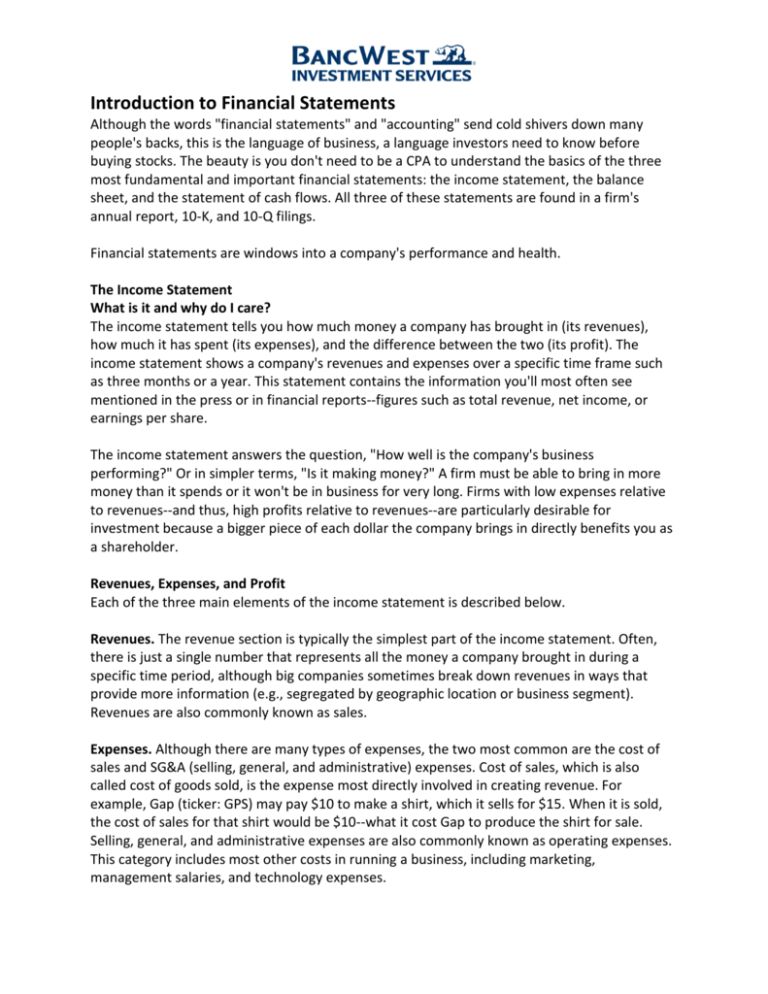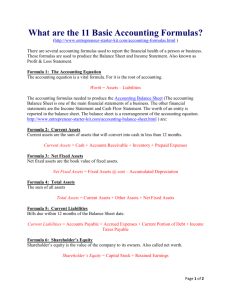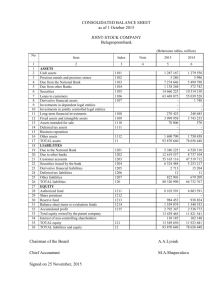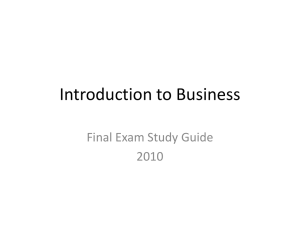
Introduction to Financial Statements
Although the words "financial statements" and "accounting" send cold shivers down many
people's backs, this is the language of business, a language investors need to know before
buying stocks. The beauty is you don't need to be a CPA to understand the basics of the three
most fundamental and important financial statements: the income statement, the balance
sheet, and the statement of cash flows. All three of these statements are found in a firm's
annual report, 10-K, and 10-Q filings.
Financial statements are windows into a company's performance and health.
The Income Statement
What is it and why do I care?
The income statement tells you how much money a company has brought in (its revenues),
how much it has spent (its expenses), and the difference between the two (its profit). The
income statement shows a company's revenues and expenses over a specific time frame such
as three months or a year. This statement contains the information you'll most often see
mentioned in the press or in financial reports--figures such as total revenue, net income, or
earnings per share.
The income statement answers the question, "How well is the company's business
performing?" Or in simpler terms, "Is it making money?" A firm must be able to bring in more
money than it spends or it won't be in business for very long. Firms with low expenses relative
to revenues--and thus, high profits relative to revenues--are particularly desirable for
investment because a bigger piece of each dollar the company brings in directly benefits you as
a shareholder.
Revenues, Expenses, and Profit
Each of the three main elements of the income statement is described below.
Revenues. The revenue section is typically the simplest part of the income statement. Often,
there is just a single number that represents all the money a company brought in during a
specific time period, although big companies sometimes break down revenues in ways that
provide more information (e.g., segregated by geographic location or business segment).
Revenues are also commonly known as sales.
Expenses. Although there are many types of expenses, the two most common are the cost of
sales and SG&A (selling, general, and administrative) expenses. Cost of sales, which is also
called cost of goods sold, is the expense most directly involved in creating revenue. For
example, Gap (ticker: GPS) may pay $10 to make a shirt, which it sells for $15. When it is sold,
the cost of sales for that shirt would be $10--what it cost Gap to produce the shirt for sale.
Selling, general, and administrative expenses are also commonly known as operating expenses.
This category includes most other costs in running a business, including marketing,
management salaries, and technology expenses.
Profits. In its simplest form, profit is equal to total revenues minus total expenses. However,
there are several commonly used profit subcategories investors should be aware of. Gross
profit is calculated as revenues minus cost of sales. It basically shows how much money is left
over to pay for operating expenses (and hopefully provide profit to stockholders) after a sale is
made. Using our example of the Gap shirt before, the gross profit from the sale of the shirt
would have been $5 ($15 sales price - $10 cost of sales = $5 gross profit). Operating profit is
equal to revenues minus the cost of sales and SG&A. This number represents the profit a
company made from its actual operations, and excludes certain expenses and revenues that
may not be related to its central operations. Net income generally represents the company's
profit after all expenses, including financial expenses, have been paid. This number is often
called the "bottom line" and is generally the figure people refer to when they use the word
"profit" or "earnings."
The Balance Sheet
What is it and why do I care?
The balance sheet, also known as the statement of financial condition, basically tells you how
much a company owns (its assets), and how much it owes (its liabilities). The difference
between what it owns and what it owes is its equity, also commonly called "net assets,"
"stockholder's equity," or "net worth."
The balance sheet provides investors with a snapshot of a company's health as of the date
provided on the financial statement. Generally, if a company has lots of assets relative to
liabilities, it's in good shape. Conversely, just as you would be cautious loaning money to a
friend who is burdened with large debts, a company with a large amount of liabilities relative to
assets should be scrutinized more carefully.
Assets, Liabilities, and Equity
Each of the three primary elements of the balance sheet is described below.
Assets. There are two main types of assets: current assets and noncurrent assets. Within these
two categories, there are numerous subcategories. Current assets are likely to be used up or
converted into cash within one business cycle--usually defined as one year. For example, the
groceries at your local supermarket would be classified as current assets because apples and
bananas should be sold within the next year. Noncurrent assets are defined by our left-brained
accountant friends as, you guessed it, anything not classified as a current asset. For example,
the refrigerators at your supermarket would be classified as noncurrent assets because it's
unlikely they will be "used up" or converted to cash within a year.
Liabilities. Similar to assets, there are two main categories of liabilities: current liabilities and
noncurrent liabilities. Current liabilities are obligations the firm must pay within a year. For
example, your supermarket may have bought and received $1,000 worth of eggs from a local
farm but won't pay for them until next month. Noncurrent liabilities are the flip side of
noncurrent assets. These liabilities represent money the company owes one year or more in the
future. For example, the grocer may borrow $1 million from a bank for a new store, which it
must pay back in five years.
Equity. Equity represents the part of the company that is owned by shareholders; thus, it's
commonly referred to as shareholder's equity. As described above, equity is equal to total
assets minus total liabilities. Although there are several categories within equity, the two
biggest are paid-in capital and retained earnings. Paid-in capital is the amount of money
shareholders paid for their shares when the stock was first offered to the public. It basically
represents how much money the firm received when it sold its shares. Retained earnings
represent the total profits the company has earned since it began, minus whatever has been
paid to shareholders as dividends. Since this is a cumulative number, if a company has lost
money over time, retained earnings can be negative and would be renamed "accumulated
deficit."
The Statement of Cash Flows
What is it and why do I care?
The statement of cash flows tells you how much cash went into and out of a company during a
specific time frame such as a quarter or a year. You may wonder why there's a need for such a
statement because it sounds very similar to the income statement, which shows how much
revenue came in and how many expenses went out.
The difference lies in a complex concept called accrual accounting. Accrual accounting requires
companies to record revenues and expenses when transactions occur, not when cash is
exchanged. While that explanation seems simple enough, it's a big mess in practice, and the
statement of cash flows helps investors sort it out.
The statement of cash flows is very important to investors because it shows how much actual
cash a company has generated. The income statement, on the other hand, often includes
noncash revenues or expenses, which the statement of cash flows excludes.
One of the most important traits you should seek in a potential investment is the firm's ability
to generate cash. Many companies have shown profits on the income statement but stumbled
later because of insufficient cash flows. A good look at the statement of cash flows for those
companies may have warned investors that rocky times were ahead.
The Three Elements of the Statement of Cash Flows
Because companies can generate and use cash in several different ways, the statement of cash
flows is separated into three sections: cash flows from operating activities, from investing
activities, and from financing activities.
The cash flows from operating activities section shows how much cash the company generated
from its core business, as opposed to peripheral activities such as investing or borrowing.
Investors should look closely at how much cash a firm generates from its operating activities
because it paints the best picture of how well the business is producing cash that will ultimately
benefit shareholders.
The cash flows from investing activities section shows the amount of cash firms spent on
investments. Investments are usually classified as either capital expenditures--money spent on
items such as new equipment or anything else needed to keep the business running--or
monetary investments such as the purchase or sale of money market funds.
The cash flows from financing activities section includes any activities involved in transactions
with the company's owners or debtors. For example, cash proceeds from new debt, or
dividends paid to investors would be found in this section.
Free cash flow is a term you will become very familiar with over the course of these workbooks.
In simple terms, it represents the amount of excess cash a company generated, which can be
used to enrich shareholders or invest in new opportunities for the business without hurting the
existing operations; thus, it's considered "free." Although there are many methods of
determining free cash flow, the most common method is taking the net cash flows provided by
operating activities and subtracting capital expenditures (as found in the "cash flows from
investing activities" section).
Cash from Operations - Capital Expenditures = Free Cash Flow
The Bottom Line
While there are far more exciting aspects about investing in stocks than learning about
accounting and financial statements, it's essential for investors to know the language of
business.
You should consider the investment objectives, risks, and charges and expenses of the fund
or ETF carefully before investing. This and other information may be found in the
prospectus and/or, if available, the summary prospectus. To obtain one, please visit the
fund company’s website or if you are a BancWest Investment Services client, log in to
bankofthewest.com to access online. Always carefully read the prospectus and/or, if
available, the summary prospectus carefully before you invest or send money.
Money market funds are neither FDIC-insured nor guaranteed by the U.S. government or
government agency and are not deposits or obligations of, or guaranteed by, any bank.
Although money market funds attempt to maintain a constant net asset value of $1.00 per
share, there can be no guarantee that they will be able to do so. It is possible to lose money
by investing in money market funds.
© 2014 Morningstar, Inc. All Rights Reserved. The information contained herein: (1) is
proprietary to Morningstar and/or its content providers; (2) may not be copied or distributed; and
(3) is not warranted to be accurate, complete or timely. Neither Morningstar nor its content
providers are responsible for any damages or losses arising from any use of this
information. Past performance is no guarantee of future results.
Securities and variable annuities are offered through BancWest Investment Services, a registered
broker/dealer, Member FINRA/SIPC. Bank of the West and its various affiliates and subsidiaries
are not tax or legal advisors.
BancWest Investment Services is a wholly owned subsidiary of Bank of the West and a part of
the Wealth Management Group. BancWest Corporation is the holding company for Bank of the
West. BancWest Corporation is a wholly owned subsidiary of BNP Paribas.
Investment and Insurance Products:
NOT FDIC
INSURED
NOT BANK
GUARANTEED
MAY LOSE VALUE
NOT A
DEPOSIT
NOT INSURED BY ANY FEDERAL
GOVERNMENT AGENCY









